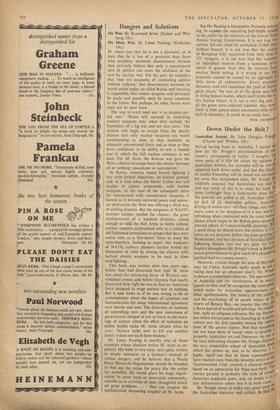Dangers and Solutions
M. ARON says that he is not a pessimist, or at least that he is less of a pessimist than those
who prophesy universal disarmament because they privately believe that only a supernatural turn of politics can avert the abolition of the race by nuclear war. For his part, he considers
that 'men are incapable of conducting politics without violence,' that disarmament between, or
world union under, an allied Russia and America is impossible, that atomic weapons will obviously be made and possibly used by many countries in the future. But perhaps, he adds, future wars need not be total wars.
The way to avert total war is to prepare par- tial war: 'States will succeed in outlawing
modern weapons only when they exclude the
hypothesis of a big war and not vice versa.' The nations will begin to escape from the deadly
illusion that only nuclear weapons are worth
accumulating as soon as they maintain an adequate conventional force and as soon as they have confidence in its ability to win a limited war in which the full nuclear armoury is not used. For M. Aron, the Korean war gave the West a chance to escape from this choice 'between all or nothing; apocalypse or capitulation.' In Korea, America found herself fighting a war with limited objectives, on limited ground,
and, at a time when the Soviet Union was still
weaker in atomic armaments, with limited weapons. At the time of the subsequent drive
for rearmament with conventional weapons, it
looked as if between universal peace and univer- sal destruction the West was offering a third way of settling disputes. But the stinginess of NATO's member nations spoiled the chance : the great reinforcement of a hundred divisions, strong enough to hold the Red Army in battle without nuclear suppoM ,materialised only as a trickle of old-fashioned formations so meagre that they were
useful only, as a 'fire-alarm' force to warn the
atom-bombers. Seeking to repair this weakness of NATO, military planners further buried the distinction of roles by arming the alliance with tactical atomic weapons to be used in close land fighting. This book was written over two years ago, before Suez had illustrated how right M. Aron was about the advancing decay of Western con- ventional armies and before Quemoy had nearly illustrated how' right he was to fear an American force designed to wage nuclear war or nothing. But it now looks as if he was wrong to be so contemptuous about the hopes of scientists and humanitarians for some international agreement over bombs and tests. The discovery of methods of controlling tests and the new uneasiness of governments obliged' at last to listen to the warn- ings of science about the effect of radiation on public health make M. Aron absurd when he says : 'Science helps men to kill one another faster; it does not teach them wisdom.' Dr. Linus Pauling is exactly one of those scientists whose idealism makes M. Aron so im- patient. His book is very clear, very quiet, written in simple sentences 'as a layman's manual of atomic dangers, and he believes that a World Peace Research Organisation should be founded to find out the recipe for peace like the recipe for penicillin. He would place his huge organi- sation 'in some rural or semi-rural community, suitable to its activities of slow, thoughtful attack on great problems. . . .' One can imagine the sophisticated, despairing laughter of M. Aron. But Dr. Pauling is formidable. Patiently teas ing, he exposes the reassuring half-truths hand to the public by the scientists of the United States Atomic Energy Commission. It is not true thal current fall-out could be multiplied 15,000 times without hazard, it is not true that the natives of Rongelap fully recovered from their dose of 175 rontgens, it is not true that the radiation an individual receives from a luminous wrist' watch is greater than that he receives from nuclear bomb testing, it is wrong to say that leultwmia cannot be caused by an aggregate of little doses of radioactivity. Every explosion threatens with evil mutations the 'pool of human germ plasm,' the sum of all the genes now he in living human bodies, which itself holds the ea: tire human future. It is not a very big sum. I; all the genes were collected together, they wool' form 'a little sphere about one-twenty-fifth of an inch in diameter.' It could be so easily lost. NEAL ASCHERSON


































 Previous page
Previous page